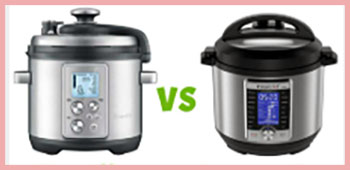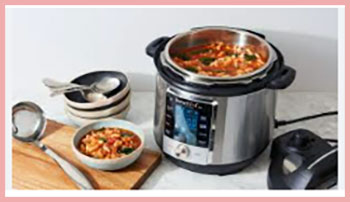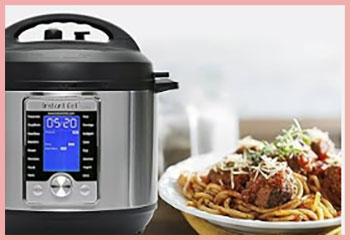Choosing between the Instant Pot Pro and Ultra can feel like comparing two rockstars in the kitchen appliance world—each one brilliant in its own way, but for totally different reasons. If you’re wondering whether to go all-in on smart tech or crave precision with every pressure-cooked bite, this guide is for you.

I’ve spent countless hours cooking with both models, experimenting with everything from weekday curries to weekend desserts, and I’ve put together this no-nonsense comparison to help you decide which Instant Pot deserves a spot on your countertop.
Let’s dive into the specs first with a quick comparison table.
Instant Pot Pro vs. Ultra Comparison Table
| Feature | Instant Pot Pro | Instant Pot Ultra |
| Capacity | 6-quart, 8-quart | 3-quart, 6-quart, 8-quart |
| Cooking Programs | 28 one-touch programs | 10 one-touch programs, Ultra mode |
| Pressure Levels | High, Low | High, Low, Custom (Ultra mode) |
| Inner Pot | Stainless steel with handles, stovetop-safe | Stainless steel, no handles |
| Control Panel | Digital touchscreen, intuitive | Digital with dial, customizable |
| Smart Features | Wi-Fi, app control (Pro Plus) | None |
| Special Features | Baking mode, WhisperQuiet steam release | Altitude adjustment, Ultra mode |
| Wattage | 1200W (6-quart), 1500W (8-quart) | 1000W (6-quart), 1200W (8-quart) |
| Price (6-quart) | ~$130-$170 | ~$120-$150 |
| Best For | Busy cooks, tech enthusiasts | Precision cooks, high-altitude users |
My Journey with Instant Pot: Why I’m Comparing Pro and Ultra
I’ve been using Instant Pots for years, ever since I realized I could make a pot roast in under an hour without babysitting a stove. The Pro and Ultra caught my eye because they’re often hailed as top-tier models, each with unique strengths.
The Pro feels like the modern, tech-savvy choice, while the Ultra appeals to those who crave control over every detail. I’ve cooked everything from creamy risottos to tender ribs in both, and I’m here to share what I’ve learned—warts and all—so you can pick the right one for your kitchen.
Unboxing the Instant Pot Pro: First Impressions
When I unboxed the Instant Pot Pro, I was struck by its sleek, modern look. The glossy black finish and large digital touchscreen screamed “high-tech.” It’s heavier than older models, but the lightweight inner pot with silicone handles made it easy to maneuver. I immediately appreciated the intuitive control panel—no fumbling through a cluttered display.

The Pro comes in 6-quart and 8-quart sizes, perfect for my family of four, and boasts 28 one-touch cooking programs. From pressure cooking to baking, it’s like having a sous-chef in a single appliance.
The Pro Plus variant, which I also tested, adds Wi-Fi connectivity, letting me control it from my phone. I’ll admit, starting a slow-cook session from my couch felt like living in the future. The WhisperQuiet steam release was another pleasant surprise—none of that loud, startling hiss I’d grown used to with older models. But it’s not perfect. The Pro’s size can dominate smaller counters, and the app, while handy, occasionally lagged during setup.
Exploring the Instant Pot Ultra: A Different Vibe
The Ultra, by contrast, has a more traditional feel with its stainless steel exterior and prominent dial. Available in 3-quart, 6-quart, and 8-quart sizes, it’s versatile for solo cooks or larger households. The Ultra’s claim to fame is its customizability, thanks to the “Ultra mode” that lets you fine-tune temperature and pressure to exact degrees. As someone who lives at sea level, I didn’t need the altitude adjustment feature, but I can see its value for mountain-dwelling cooks.
The Ultra’s control panel, with its bright blue display and dial, feels less intuitive than the Pro’s touchscreen but offers granular control. I found myself tweaking settings for a beef stew, adjusting the pressure to get the texture just right. However, the lack of handles on the inner pot was a letdown—grabbing a hot pot with oven mitts isn’t my idea of fun. Also, with only 10 one-touch programs, it feels less versatile than the Pro for quick meals.
Key Features: What Sets Them Apart
Let’s break down the features that define these two models. The Pro is a multi-tasker’s dream, with 28 cooking programs covering everything from rice to cake. Its inner pot, with a 3.5mm aluminum layer, heats faster and more evenly, making it a champ for sautéing. The Pro Plus’s Wi-Fi and app control let you access over 800 recipes and monitor cooking remotely. I loved using the app to scale a chili recipe for six servings, though the app’s recipe measurements (like “0.63 oz of tomatoes”) could be clearer.
The Ultra, meanwhile, shines for precision. Its Ultra mode lets you set exact temperatures and pressures, which I found useful for delicate dishes like custards. The altitude adjustment is a niche but valuable feature, ensuring consistent results at high elevations. However, it lacks the Pro’s smart features and has fewer presets, which might frustrate beginners looking for one-touch simplicity.
Pros and Cons: Instant Pot Pro
Pros
- Versatile Cooking Programs: With 28 presets, I could whip up yogurt, sterilize bottles, or bake a cake without a second thought. The variety is a game-changer for busy nights.
- Intuitive Touchscreen: The clear, responsive display made selecting functions a breeze, even when I was multitasking.
- Smart Features (Pro Plus): Wi-Fi connectivity let me start dinner from my office, and the app’s recipe library inspired new dishes.
- WhisperQuiet Steam Release: The quieter, safer steam release was a relief, especially with kids running around.
- Stovetop-Safe Inner Pot: I could sear meat on the stove, then pop the pot back into the Pro for pressure cooking—fewer dishes to wash!
Cons
- Bulky Size: The Pro’s footprint is substantial. In my small kitchen, it hogged counter space, making storage a puzzle.
- App Glitches: The Pro Plus’s app occasionally froze during setup, which was frustrating when I was eager to start cooking.
- Pricey: At $130-$170 for the 6-quart, it’s a bigger investment than the Ultra, especially if you don’t need smart features.
- Learning Curve for Beginners: With so many programs, it can overwhelm new users who just want to make a simple soup.
Pros and Cons: Instant Pot Ultra
Pros

- Precision Cooking: The Ultra mode’s custom settings gave me control over pressure and temperature, perfect for finicky recipes like sous vide.
- Altitude Adjustment: A lifesaver for high-altitude cooks, ensuring recipes turn out as intended.
- Versatile Sizes: The 3-quart option is great for small households, while the 6- and 8-quart sizes suit larger families.
- Reliable Performance: My dishes, from risotto to bone broth, came out consistently well, with rich flavors in less time.
- Slightly Cheaper: Priced at $120-$150 for the 6-quart, it’s a bit more budget-friendly than the Pro.
Cons
- No Inner Pot Handles: I struggled to remove the hot pot safely, which felt like a design oversight.
- Fewer Presets: With only 10 programs, it lacks the Pro’s one-touch versatility, requiring more manual adjustments.
- Clunky Controls: The dial and button combo felt less intuitive, especially compared to the Pro’s sleek touchscreen.
- No Smart Features: Without Wi-Fi or app support, it feels less modern, especially for tech-savvy cooks.
Performance in the Kitchen: My Cooking Tests
To really put these machines to the test, I cooked identical dishes in both: a classic chicken curry, a batch of jasmine rice, and a chocolate lava cake. Here’s how they stacked up.
Chicken Curry
The Pro’s sauté function heated up faster, giving the chicken a nice sear before pressure cooking. Its high-pressure setting cooked the curry in 20 minutes, with tender meat and vibrant flavors. The Ultra took a bit longer to come to pressure, likely due to its lower wattage (1000W vs. the Pro’s 1200W for the 6-quart). However, I used the Ultra’s custom settings to tweak the pressure, resulting a slightly richer sauce—though it required more babysitting.
Jasmine Rice
The Pro’s dedicated rice program was a winner. I added a 1:1 rice-to-water ratio, hit the button, and got fluffy grains in 4 minutes, no soaking required. The Ultra’s rice setting, however, overcooked my rice slightly, turning it mushy. I later learned I could adjust the time manually, but it was a hassle compared to the Pro’s set-and-forget ease.
Chocolate Lava Cake
The Pro’s baking mode made this dessert a breeze. The cake came out gooey in the center, just as I wanted, in about 10 minutes under pressure. The Ultra required me to use the Ultra mode to set a specific temperature, which worked well but took more effort to dial in. Both delivered delicious results, but the Pro felt more beginner-friendly.
Cleaning and Maintenance: A Real-World Perspective
Cleaning is where the Pro pulls ahead. Its inner pot, lid, and condensation collector are dishwasher-safe, which saved me time after a messy chili cook-off. The Ultra’s pot and lid are also dishwasher-safe, but the lack of handles made handling the hot pot trickier. Both models need regular maintenance—cleaning the sealing ring and steam valve to prevent odors—but the Pro’s WhisperQuiet steam release cover was easier to remove and clean than the Ultra’s standard valve.
Which One Fits Your Lifestyle?
Choosing between the Pro and Ultra depends on your cooking style and needs. If you’re like me, juggling a busy schedule and craving convenience, the Pro’s one-touch programs and smart features (in the Pro Plus) make life easier. It’s ideal for families or anyone who wants a do-it-all appliance. The Ultra, however, is perfect for control freaks who love tweaking recipes or live at high altitudes. Its smaller 3-quart option also suits solo cooks or small kitchens.
My Personal Take: The Pro Edges Out, But…
After weeks of testing, the Pro became my go-to. Its versatility, intuitive controls, and smart features fit my hectic life. I loved starting a slow-cook session from my phone while stuck in a meeting. But the Ultra’s precision won me over for specific dishes, like a silky flan where I could dial in the exact temperature. If budget is a concern, the Ultra’s lower price might tip the scales, especially if you don’t need Wi-Fi or extra presets.
Frequently Asked Questions (FAQ)
It’s an 8.5-quart multi-cooker with 8 functions, including slow cooking, searing, and baking. It features Triple Fusion Heat and an oven-safe pot.
Yes, both models cook rice well using the Steam or Boil function. Use a 1:1 ratio for white rice and 1.25:1 for brown.
Absolutely, if you value versatility and large capacity. The standard model’s a budget-friendly workhorse; the Pro’s premium features justify the cost for enthusiasts.
The Pro edges out for its faster cooking and oven-safe pot, but the standard model’s great for budget-conscious cooks needing versatility.
Also Read: Ooni vs. Alfa Pizza Oven
Conclusion
After weeks of cooking with the Ninja Foodi PossibleCooker and Pro, I’m hooked on their versatility. Whether you’re whipping up a quick weeknight meal or hosting a big gathering, these multi-cookers deliver. The standard PossibleCooker is your go-to for affordable, reliable performance, while the Pro’s advanced features elevate your culinary game. Pick the one that fits your budget and cooking style, and you’ll wonder how you ever managed without it. Which will you choose to transform your kitchen?
